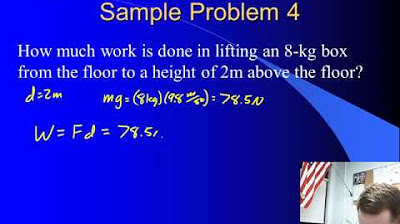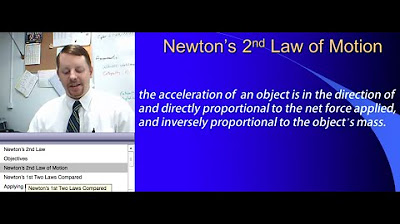High School Physics - Relative Motion
TLDRIn this informative talk, Mr. Fullerton explains the concept of relative motion, emphasizing that motion is always described with respect to a reference frame. He illustrates this with examples from everyday life, such as a person walking on Earth and an alien observing from space, highlighting the differences in perceived motion. The discussion progresses to calculating velocities within different reference frames and introduces the principle of velocity addition. Through practical examples involving trains, planes, and relative velocities, Mr. Fullerton demonstrates how to solve problems in one and two dimensions, reinforcing the idea that motion is relative and can be mathematically described using the addition of velocities.
Takeaways
- 🌟 The concept of relative motion emphasizes that motion is always described with respect to a chosen reference frame.
- 🚀 A reference frame is a perspective from which motion is observed, commonly the Earth in everyday scenarios.
- 👽 Even stationary objects can appear to be in motion when viewed from different reference frames, such as an alien spaceship versus an observer on Earth.
- 📐 In physics, it is often assumed that we are in a non-accelerating reference frame for simplicity, despite Earth's rotation and other factors.
- 🛫 There is no distinguishable difference between an object at rest and one moving at a constant velocity within an inertial reference frame.
- 🚂 Calculating the velocity of an object relative to a reference frame involves dividing the displacement by the time taken.
- 🔄 The addition of velocities follows a specific notation where the first and last letters represent the objects and the middle letters represent intermediate reference frames.
- 🔢 The velocity of an object with respect to a reference frame is found by adding the velocities of intermediate objects in sequence.
- 🛫 For two-dimensional relative motion problems, vector addition and the Pythagorean theorem are used to find the resultant velocity.
- 🌐 In real-world examples, such as a person running on a train or an airplane flying with respect to the air and ground, relative velocities help determine the object's velocity with respect to the ground.
- 📝 Practice is key to understanding relative motion, and creating and solving problems with multiple objects can solidify this concept.
Q & A
What is the main concept discussed in the transcript?
-The main concept discussed in the transcript is relative motion, emphasizing that motion is relative to a chosen reference frame and how to calculate the velocity of an object with respect to different reference frames.
How does the reference frame affect the observation of motion?
-The reference frame affects the observation of motion by determining what is considered in motion and what is considered stationary. Different reference frames can lead to different observations of the same scenario, as illustrated by the example of the person walking relative to the room on Earth and the alien observing from space.
What is an inertial reference frame?
-An inertial reference frame is a reference frame that is either at rest or moving at a constant velocity. The laws of physics as studied in the transcript's course assume that the reference frame is inertial, despite the Earth's rotation, because the effects are typically negligible for problems on Earth.
Why is it impossible to distinguish between motion at rest and motion at constant velocity in an inertial reference frame?
-It is impossible to distinguish between motion at rest and motion at constant velocity in an inertial reference frame because there are no apparent effects or experiments that can be conducted to differentiate between the two states within such a frame.
How is the velocity of an object calculated with respect to a reference frame?
-The velocity of an object with respect to a reference frame is calculated by dividing the displacement of the object by the time it took to achieve that displacement.
What is the rule for adding velocities when dealing with multiple reference frames?
-The rule for adding velocities when dealing with multiple reference frames is to add the velocity of the object with respect to an intermediate reference frame to the velocity of that intermediate frame with respect to the final reference frame.
How do you find the velocity of an object with respect to the ground if it is moving with respect to another moving object?
-To find the velocity of an object with respect to the ground, you add the velocity of the object with respect to the moving object to the velocity of that moving object with respect to the ground.
What is the result of the example where a man runs at 5 m/s west on a train moving at 60 m/s east?
-The result is that the man's velocity with respect to the ground is 55 m/s to the east, calculated by adding the train's velocity (60 m/s) and the man's velocity (-5 m/s).
In the airplane example, what is the plane's velocity with respect to the ground?
-The plane's velocity with respect to the ground is 265 m/s, calculated by adding the plane's velocity with respect to the air (250 m/s) and the air's velocity with respect to the ground (15 m/s).
How is the velocity addition handled in two-dimensional problems like the airplane flying east and the air moving north?
-In two-dimensional problems, the velocity addition is handled as a vector addition problem. The resultant velocity is found by taking a straight line from the starting point of the first vector to the ending point of the last, using the Pythagorean theorem to calculate the magnitude.
What is the final velocity of the airplane in the two-dimensional problem, and how is it calculated?
-The final velocity of the airplane in the two-dimensional problem is approximately 252 m/s. It is calculated by adding the velocity vector of the plane with respect to the air (250 m/s east) and the velocity vector of the air with respect to the ground (35 m/s north) using vector addition.
Outlines
🌟 Introduction to Relative Motion
This paragraph introduces the concept of relative motion, explaining that motion is described from a specific reference frame. Mr. Fullerton uses the example of observing someone walking from his desk on Earth and contrasts it with an alien's perspective from outer space to illustrate that motion is relative. The paragraph emphasizes that the laws of physics in the course assume a non-inertial, non-accelerating reference frame, which is a simplification for practical purposes. It concludes with the idea that it's impossible to distinguish between being at rest or moving at a constant velocity in an inertial reference frame, using the example of an airplane to demonstrate this concept.
📐 Calculating Velocity in Different Reference Frames
This paragraph delves into the mathematical aspect of relative motion, explaining how to calculate the velocity of an object with respect to different reference frames. It introduces the concept of adding velocities, where the velocity of one object with respect to another is the sum of the velocities of intermediate objects. The paragraph provides examples to illustrate this concept, such as calculating the velocity of a man on a train with respect to the ground, and the velocity of a plane with respect to the air and then the ground. It concludes with a two-dimensional problem involving vector addition to find the resultant velocity of a plane with respect to the ground, emphasizing the practical application of these concepts.
Mindmap
Keywords
💡Relative Motion
💡Frame of Reference
💡Velocity
💡Inertial Reference Frame
💡Constant Velocity
💡Addition of Velocities
💡Vector
💡Parabolic Path
💡Non-Accelerating Reference Frame
💡Pythagorean Theorem
💡Two-Dimensional Problem
Highlights
Introduction to the concept of relative motion.
Explanation that motion is described relative to a chosen reference frame.
Illustration of how different reference frames can perceive different motions.
Clarification that the laws of physics assume a non-accelerating reference frame for simplicity.
Discussion on the indistinguishability of motion at rest and constant velocity in an inertial reference frame.
Explanation of how to calculate the velocity of an object relative to a reference frame.
Use of displacement and time to determine velocity.
Introduction to the concept of adding velocities.
Rule of adding velocities with matching intermediate reference frames.
Example of calculating the velocity of a man on a train with respect to the ground.
Example of calculating the velocity of an airplane with respect to the ground, considering air movement.
Introduction to two-dimensional relative motion problems.
Solution to a two-dimensional problem using vector addition and the Pythagorean theorem.
Encouragement for the audience to create and solve their own relative motion problems.
Conclusion and offer for further help on the topic.
Transcripts
5.0 / 5 (0 votes)
Thanks for rating:





